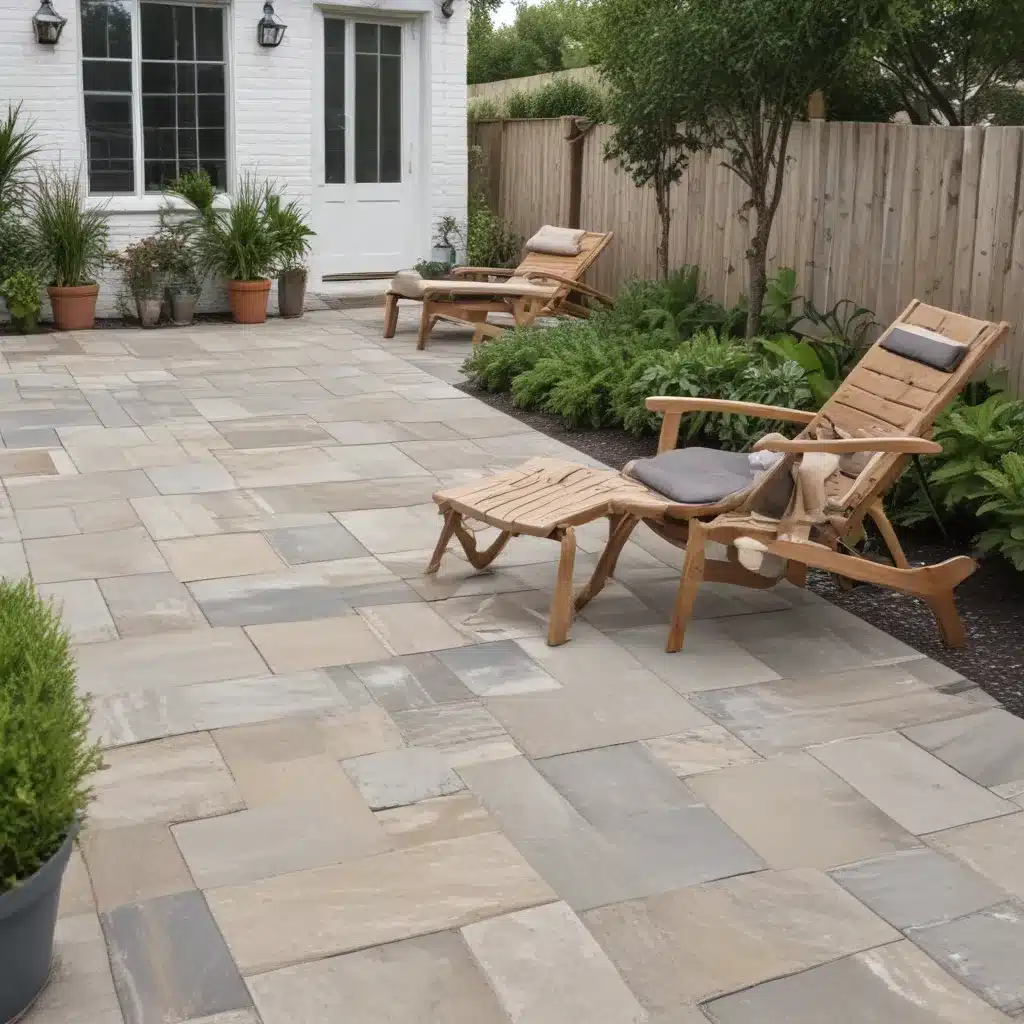
When you’re blessed with a small outdoor space, the idea of crafting a relaxing, functional patio can feel like a daunting challenge. However, with the right design approach and strategic paving solutions, you can transform even the tightest of yards into a stylish, spacious-feeling oasis. As an experienced outdoor living consultant, I’m here to share practical tips and insightful hacks to help you make the most of your petite patio.
Patio Paving Trends
The foundation of any inviting outdoor living space starts with the paving. Fortunately, there are countless options to elevate even the most modest of yards. One of the biggest patio paving trends we’re seeing is the use of geometric patterns. By incorporating eye-catching shapes and angles into your paving design, you can create a sense of visual interest that draws the eye and makes the space feel larger. Whether it’s a bold herringbone layout, a striking circular pattern, or an intricate mosaic, these geometric details add depth and dynamism.
For a more natural, rustic feel, natural stone textures are also hugely popular. Materials like flagstone, travertine, and bluestone offer a timeless aesthetic while adding visual contrast. The unique variations and imperfections in these paving stones can make a small patio feel more organic and expansive. Plus, their slip-resistant surfaces are perfect for creating safe, all-weather outdoor living areas.
And for homeowners seeking an environmentally friendly option, permeable paving solutions are becoming increasingly sought-after. By allowing water to permeate through the surface, these pavers help reduce runoff and mitigate flood risks – a crucial consideration for small yards. Permeable concrete, porous pavers, and even gravel can be viable, eco-conscious choices that complement a variety of design styles.
Outdoor Design Ideas
Beyond the foundation of your patio, the overall design of the space plays a crucial role in maximizing a small yard. One smart strategy is to incorporate compact seating arrangements. Rather than bulky, oversized furniture that dominates the limited square footage, opt for streamlined pieces with thin frames and narrow profiles. Modular sectionals, petite bistro sets, and built-in benches can provide ample seating without overwhelming the area.
Another game-changing technique is to harness the power of vertical gardening. By utilizing walls, trellises, and other upright structures, you can add lush greenery and visual interest without sacrificing precious ground space. Climbing vines, hanging baskets, and tiered planter walls are just a few ways to cultivate a verdant, space-saving oasis.
Lastly, don’t underestimate the value of multipurpose patio features. Things like an outdoor fireplace that doubles as a coffee table, a bench with built-in storage, or a pergola that provides both shade and a mounting point for string lights can help you maximize the functionality of your small yard. Every inch counts, so look for clever ways to blend form and function.
Installation Techniques
When it comes to actually installing your patio, there are several techniques that can help create a seamless, spacious-feeling outdoor living area. Permeable paving solutions, for instance, not only offer eco-friendly benefits but can also provide a visually cohesive look. By allowing water to filter through the surface, these pavers help reduce the “boxed-in” feeling that can come with traditional hardscaping.
Interlocking paver systems are another smart choice for small yards. These modular designs make installation a breeze, and their precision-cut edges create a clean, professional finish. Plus, the ability to mix and match shapes, sizes, and colors allows for endless customization to suit your unique space.
When it comes to the actual surface finish, aiming for a smooth, level patio is essential. Uneven or undulating pavement can make a small area feel even more cramped and cluttered. By working with experienced installers who can ensure a perfectly flat, slip-resistant surface, you’ll create the illusion of a larger, more cohesive outdoor room.
Maintenance Guidelines
Of course, no discussion of patio paving would be complete without addressing the importance of proper maintenance. Regular cleaning and sealing of your paving stones or concrete can help preserve their appearance and functionality for years to come. Addressing issues like weed growth and moss buildup is also key to maintaining a tidy, welcoming look.
And in the event that repairs are needed, it’s crucial to act quickly. Damaged or uneven pavers can pose tripping hazards and detract from the overall aesthetic. Fortunately, patio paving replacement is relatively straightforward, allowing you to easily swap out individual stones or sections as needed.
Cost Comparisons
When budgeting for your small-yard patio project, there are several factors to consider. Material expenses can vary widely, from cost-effective options like concrete or gravel to more premium natural stones. Labor and installation costs will also depend on the complexity of your design and the expertise of your chosen contractor.
One important aspect to factor in is long-term maintenance budgeting. While some paving materials may have a lower upfront cost, the ongoing needs for cleaning, sealing, and potential repairs can add up over time. Carefully weighing these lifecycle expenses can help you make the most informed decision for your home and your wallet.
By exploring the latest patio paving trends, incorporating clever outdoor design ideas, and leveraging strategic installation techniques, you can transform even the most modest of yards into a beautifully functional, spacious-feeling oasis. And with the right maintenance plan in place, your new patio can provide years of enjoyment and added home value. Ready to get started? Contact Cincinnati Patiopaving today to begin planning your small-space patio makeover.

